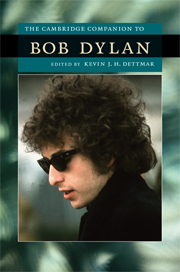Book contents
- Frontmatter
- Introduction
- Part I Perspectives
- 1 Bob Dylan and the Anglo-American tradition
- 2 Bob Dylan and Rolling Thunder
- 3 Bob Dylan as songwriter
- 4 Bob Dylan as performer
- 5 Bob Dylan and collaboration
- 6 Bob Dylan and gender politics
- 7 Bob Dylan and religion
- 8 Bob Dylan and the Academy
- 9 Bob Dylan as cultural icon
- Part II Landmark Albums
- Works cited
- Index
3 - Bob Dylan as songwriter
from Part I - Perspectives
Published online by Cambridge University Press: 28 May 2009
- Frontmatter
- Introduction
- Part I Perspectives
- 1 Bob Dylan and the Anglo-American tradition
- 2 Bob Dylan and Rolling Thunder
- 3 Bob Dylan as songwriter
- 4 Bob Dylan as performer
- 5 Bob Dylan and collaboration
- 6 Bob Dylan and gender politics
- 7 Bob Dylan and religion
- 8 Bob Dylan and the Academy
- 9 Bob Dylan as cultural icon
- Part II Landmark Albums
- Works cited
- Index
Summary
“Who expects what? I mean anybody that expects anything from me is just a borderline case. Nobody with any kind of reality is going to expect anything from me. I've already given them enough you know, what do they want from me. You can't keep on depending on one person to give you everything.” Bob Dylan (1984), quoted in Williams, 1974-1986, 275 / “If the songs are dreamed, it's like my voice is coming out of their dream.” Bob Dylan (1966), quoted in Shelton, No Direction 354 / Does it need to be asserted that exploring Bob Dylan as a songwriter means examining every aspect of who he is as an artist, a cultural figure, and a human being? His songs are the very heart of the matter - the foundation on which his aesthetic reputation rests and the fuel for the symbolic identities and roles that he has at various points ambitiously sought, gotten entrapped by, desperately attempted to escape, and manipulated to his own benefit. For well over four decades now, the perception of Dylan as a shape-shifter has at least as much to do with the type of song he has chosen to write as with his sound, his look, his subjects, the quality of his voice and his attitude. With Dylan, who so often invites references to Shakespeare, one conclusion is inevitable: the song's the thing. And as long as we're talking about Shakespeare, another remarkable aspect of Dylan's songwriting is the “negative capability” it embodies - that is, as Keats said referring to a quality of Shakespeare's work, “when a man is capable of being in uncertainties, mysteries, doubts, without any irritable reaching after fact and reason” (letter of December 21, 1817, quoted in Noyes 1211).
- Type
- Chapter
- Information
- The Cambridge Companion to Bob Dylan , pp. 42 - 54Publisher: Cambridge University PressPrint publication year: 2009
- 1
- Cited by



